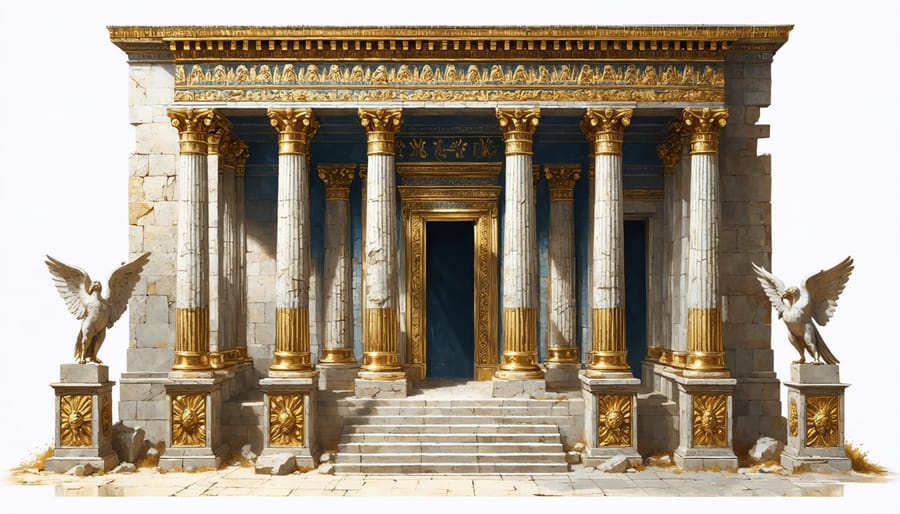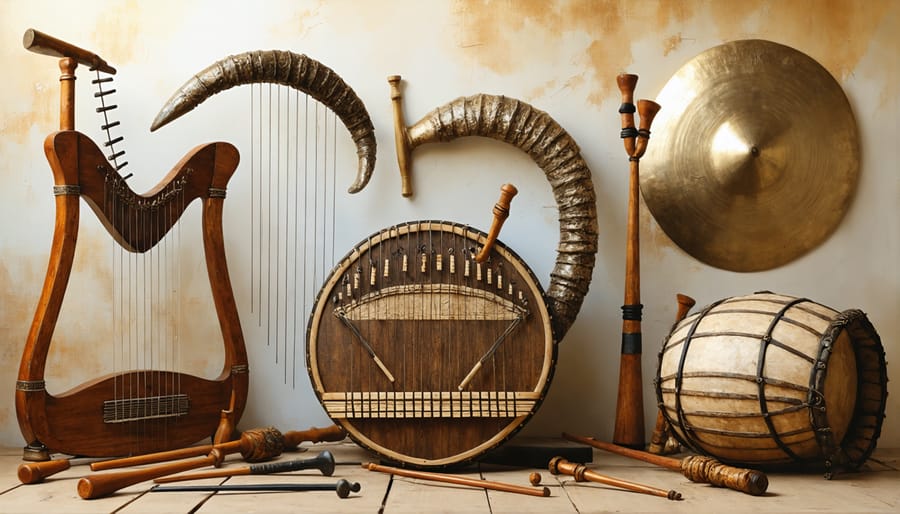From the intricate designs of Solomon’s Temple to the melodic psalms of David, the Bible stands as one of history’s most profound testimonies to the divine connection between art and faith. Throughout its pages, we discover how God not only inspired artistic expression but specifically commissioned it for His glory. The craftsmanship of Bezalel and Oholiab in creating the Tabernacle, the poetic verses of Song of Solomon, and the prophetic visions described in Revelation demonstrate that artistic expression has always been integral to worship and spiritual understanding.
As we explore the rich tapestry of biblical art, we’ll uncover how God used various art forms to communicate His truth, beauty, and majesty to His people. Whether through architecture, music, poetry, or visual arts, these creative expressions weren’t mere decorative elements but powerful vehicles for conveying divine messages and facilitating worship. They remind us that creativity itself reflects our Creator’s nature, and when dedicated to His purposes, art becomes a sacred language that bridges heaven and earth.
Join us as we journey through Scripture’s artistic landscape, discovering how these ancient expressions of creativity continue to inspire and inform our understanding of faith today.
God as the Master Artist
Creation as Divine Artistry
The very first art piece recorded in Scripture is the masterful creation of the universe itself. In Genesis 1, we witness God as the Divine Artist, crafting existence with intentional beauty and purpose. Each day of creation unfolds like a magnificent artwork, from the sweeping celestial bodies to the intricate details of every flower and creature. The poetic language used in Genesis reveals God’s artistic nature – He speaks creation into being, shapes the land with His hands, and breathes life into humanity.
God’s creative work demonstrates both grand vision and meticulous attention to detail. From the vibrant colors of sunrise to the delicate patterns on a butterfly’s wings, creation itself stands as a testament to God’s artistic expression. The Psalmist captures this divine artistry beautifully in Psalm 19:1, declaring “The heavens declare the glory of God; the skies proclaim the work of his hands.”
This initial act of creation sets the foundation for all human artistic expression, as we are made in the image of our creative God. When we create art, we reflect His nature as the Master Artist of the universe.

Made in His Image: Our Creative Heritage
Genesis 1:27 tells us that God created humanity in His own image, and this divine imprint includes the gift of creativity. Just as our Creator brought forth the universe with artistic mastery, He bestowed upon us the capacity to imagine, design, and create. This inheritance of our creative abilities reflects a profound spiritual truth: we are meant to be co-creators with God, using our talents to bring beauty and meaning into the world.
When we engage in artistic expression, whether through painting, music, dance, or craftsmanship, we participate in a sacred tradition that connects us to our Creator. This creative heritage isn’t limited to traditional artists; it manifests in countless ways, from gardening to cooking, from writing to building. Each act of creation becomes a form of worship, echoing God’s original creative work and bringing glory to His name.
Understanding this divine connection to creativity helps us appreciate why the Bible is filled with artistic expressions and why God specifically gifted artisans like Bezalel with “wisdom, understanding, knowledge, and all craftsmanship” (Exodus 31:3).
Sacred Architecture and Design
The Tabernacle’s Artistic Detail
The Tabernacle, as described in Exodus, stands as one of the most detailed artistic endeavors recorded in Scripture. God provided precise instructions for its creation, combining beauty with spiritual significance in every element. The artisans Bezalel and Oholiab, filled with divine wisdom, crafted intricate designs using precious materials including gold, silver, bronze, and fine linens in blue, purple, and scarlet.
The artistic elements included elaborately woven cherubim into the curtains, demonstrating sophisticated textile artistry. The craftsmen created detailed engravings on precious stones for the priest’s ephod and fashioned pure gold into delicate forms, including the remarkable Cherubim atop the Ark of the Covenant. Each piece reflected both skilled craftsmanship and deep spiritual symbolism.
The lampstand, or Menorah, exemplified the marriage of function and beauty, with its almond-blossom designs carefully hammered from a single piece of gold. The altar’s bronze grating showed intricate metalwork, while the priestly garments combined practical design with aesthetic beauty through their colorful embroidery and golden bells.
This divine blueprint for sacred art demonstrates how God values both beauty and purpose in worship. The Tabernacle’s artistic details weren’t merely decorative but served to create a space that inspired reverence and awe, teaching us that artistic expression can be a form of worship when dedicated to glorifying God.
Solomon’s Temple: A Masterpiece of Sacred Art
Solomon’s Temple stands as one of the most magnificent examples of sacred art and architecture described in the Bible. In 1 Kings chapters 6 and 7, we find detailed descriptions of this architectural marvel that King Solomon built to honor the Lord. The temple’s artistic elements reflected both divine inspiration and human creativity, combining to create a space of extraordinary beauty and spiritual significance.
The interior walls were adorned with intricate carvings of cherubim, palm trees, and open flowers, all overlaid with pure gold. The most sacred space, the Holy of Holies, featured two massive cherubim carved from olive wood and covered in gold, their wings spanning the entire width of the inner sanctuary. These artistic elements weren’t merely decorative but served to reflect God’s glory and majesty.
Master craftsman Huram-abi created bronze pillars with elaborate capitals decorated with pomegranates and lily work. The temple’s doors were masterfully carved with cherubim, palm trees, and flowers, demonstrating the finest woodworking of the ancient world. Even practical items like the bronze basin called the “Sea” were works of art, supported by twelve bronze oxen and decorated with ornamental buds.
This incredible fusion of architecture and sacred art served as a visible representation of God’s presence among His people, inspiring generations to worship with reverence and awe. The artistic elements of Solomon’s Temple remind us that beauty and creativity can be powerful expressions of worship and devotion to God.

Music and Poetry in Scripture
The Psalms as Artistic Expression
The Psalms stand as one of the Bible’s most beautiful examples of artistic expression, combining poetry, music, and deep spiritual truth. These divinely inspired songs showcase the full range of human emotion and experience, from jubilant praise to profound lament, all crafted with exquisite literary artistry.
Throughout the 150 Psalms, we find masterful use of poetic devices such as parallelism, metaphor, and vivid imagery. Consider Psalm 23, where David paints a serene picture of God as a shepherd leading His sheep beside still waters. Or reflect on Psalm 19, which describes the heavens declaring God’s glory in language so beautiful it has inspired countless artists and poets through the centuries.
The artistic beauty of the Psalms isn’t limited to their words alone. Many were specifically composed for musical performance, with notations about instruments, melodies, and performance directions. Terms like “selah” and references to specific musical instruments reveal that these were living works of art meant to be experienced through both word and song.
What makes the Psalms particularly remarkable is how they weave together artistic excellence with spiritual truth. Through carefully crafted verses, they express the depths of human experience while pointing to God’s faithfulness. Whether in times of joy or sorrow, the Psalms demonstrate how artistic expression can become a powerful vehicle for worship, prayer, and connecting with God.

Musical Worship in Biblical Times
Music played a central role in biblical worship, serving as a powerful medium for praising God and expressing spiritual devotion. The Book of Psalms, often called ancient Israel’s hymnbook, demonstrates the rich tradition of sacred musical worship that filled the temples and gathering places.
Scripture mentions various musical instruments used in worship, including the lyre, harp, tambourine, and trumpet. King David, known for his musical abilities, established a group of 4,000 musicians and singers specifically dedicated to temple worship (1 Chronicles 23:5). These musicians played an essential role in religious ceremonies, celebrations, and daily prayer services.
The Bible describes numerous instances where music facilitated spiritual encounters. When David played his harp, it brought peace to King Saul (1 Samuel 16:23). During the dedication of Solomon’s Temple, the sound of trumpets, cymbals, and other instruments joined with voices in praise, and the glory of the Lord filled the temple (2 Chronicles 5:13-14).
Musical worship wasn’t limited to instrumental performances. The people of Israel sang psalms, hymns, and spiritual songs, often incorporating dance and physical expression into their worship. This tradition of musical praise continues to inspire contemporary Christian worship, reminding us that artistic expression has always been a meaningful way to connect with God and express our faith.
Visual Arts and Symbolism
Sacred Symbols and Their Meanings
Throughout biblical history, sacred symbols in biblical art have served as powerful visual representations of faith, hope, and divine truth. The lamb, representing Jesus Christ as the Lamb of God, symbolizes sacrifice and redemption. This imagery, drawn from John 1:29, appears frequently in early Christian art and continues to hold deep significance today.
The dove, often depicted with an olive branch, symbolizes the Holy Spirit and God’s peace, referencing both the Genesis flood narrative and Jesus’ baptism. The fish, or “ichthys,” became an early Christian symbol of identification and fellowship, incorporating the Greek acronym for “Jesus Christ, Son of God, Savior.”
The cross, Christianity’s most recognizable symbol, represents Christ’s sacrifice and victory over death. Artists throughout history have portrayed it in countless variations, from simple wooden crosses to ornate golden crucifixes. The anchor, mentioned in Hebrews 6:19, symbolizes hope and steadfast faith, while the vine and branches reflect Jesus’ teaching in John 15 about remaining connected to Him.
The crown represents Christ’s kingship and the promise of eternal life, often paired with other symbols to create deeper meanings. The palm branch, recalling Jesus’ triumphal entry into Jerusalem, symbolizes victory and eternal peace. These enduring symbols continue to enrich Christian art, helping believers visualize and remember essential truths of their faith while providing a beautiful bridge between scripture and visual expression.
Craftsmanship in Biblical Times
The Bible richly details the work of skilled artisans who dedicated their talents to glorifying God through their craftsmanship. Perhaps the most renowned biblical craftsman was Bezalel, whom God specifically filled “with the Spirit of God, with wisdom, with understanding, with knowledge and with all kinds of skills” (Exodus 31:3). Along with Oholiab, he was divinely appointed to create the elaborate furnishings of the Tabernacle, demonstrating that artistic ability can be a spiritual gift.
These master craftsmen worked with precious metals, fine fabrics, and rare woods, creating objects of extraordinary beauty for sacred purposes. Their work included intricate embroidery, metalworking, woodcarving, and the setting of precious stones. The detailed descriptions in Exodus reveal the high value placed on excellence in craftsmanship, showing that artistic skill was viewed as a way to honor God through careful, devoted work.
In the construction of Solomon’s Temple, we see another magnificent display of craftsmanship. Hiram of Tyre, described as being “filled with wisdom, understanding, and skill” (1 Kings 7:14), crafted the temple’s bronze works with exceptional artistry. The biblical accounts describe elaborate carved cherubim, ornate palm trees, and chains of pomegranates adorning the temple’s pillars and walls.
These biblical artisans remind us that creativity and skilled workmanship can be forms of worship and service to God. Their legacy teaches us that when we use our artistic abilities with excellence and devotion, we participate in a tradition that goes back to the earliest days of our faith, where craft and worship were beautifully intertwined.
The enduring impact of biblical art resonates through the centuries, reminding us that creativity has always been central to expressing faith and glorifying God. From the intricate designs of the Temple to the poetic beauty of the Psalms, the Bible shows us that artistic expression is not merely decoration but a powerful medium for conveying divine truth and touching hearts.
Today’s Christian artists continue this sacred tradition, finding new ways to interpret and share biblical messages through various art forms. Whether through contemporary worship music, visual arts, or digital media, modern believers are discovering fresh approaches to express their faith while remaining rooted in scriptural foundations.
As we reflect on the artistic elements throughout Scripture, we’re reminded that God is the ultimate Creator, and our creative expressions can be acts of worship that draw others closer to Him. The biblical examples of art serve as inspiration and permission for believers to embrace their artistic gifts, using them to build community, enhance worship, and share the Gospel message in meaningful ways.
Let us celebrate and encourage the arts within our faith communities, recognizing that when we create with purpose and devotion, we participate in a tradition as old as our faith itself. Through art, we continue to tell God’s story, touch hearts, and invite others to experience His beauty and truth in profound ways.
